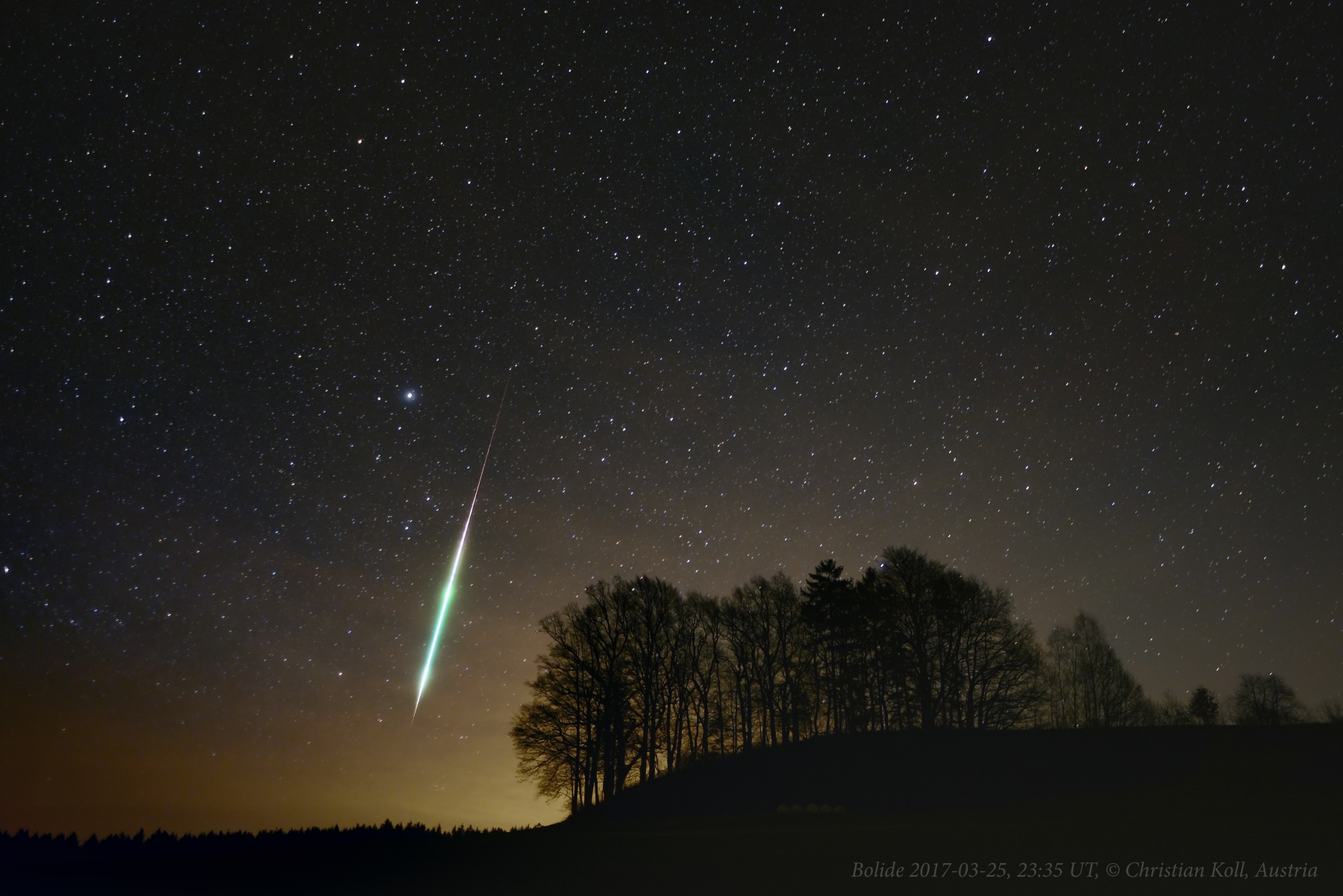
During this period the moon reaches its new phase on Wednesday April 26th. At this time the moon is located near the sun and is not visible at night. This weekend the waning crescent moon will not interfere with meteor observations as long as you face away from the moon. The slender moon will rise only a couple of hours before the sun plus the moonlight is only a fraction as bright as it was last week. The estimated total hourly meteor rates for evening observers this week is near 3 for those viewing from the northern hemisphere and 4 for those located south of the equator. For morning observers the estimated total hourly rates should be near 12 as seen from mid-northern latitudes (45N) and 13 as seen from tropical southern locations (25S). The actual rates will also depend on factors such as personal light and motion perception, local weather conditions, alertness and experience in watching meteor activity. Note that the hourly rates listed below are estimates as viewed from dark sky sites away from urban light sources. Observers viewing from urban areas will see less activity as only the brightest meteors will be visible from such locations.
The radiant (the area of the sky where meteors appear to shoot from) positions and rates listed below are exact for Saturday night/Sunday morning April 22/23. These positions do not change greatly day to day so the listed coordinates may be used during this entire period. Most star atlases (available at science stores and planetariums) will provide maps with grid lines of the celestial coordinates so that you may find out exactly where these positions are located in the sky. A planisphere or computer planetarium program is also useful in showing the sky at any time of night on any date of the year. Activity from each radiant is best seen when it is positioned highest in the sky, either due north or south along the meridian, depending on your latitude. It must be remembered that meteor activity is rarely seen at the radiant position. Rather they shoot outwards from the radiant so it is best to center your field of view so that the radiant lies at the edge and not the center. Viewing there will allow you to easily trace the path of each meteor back to the radiant (if it is a shower member) or in another direction if it is a sporadic. Meteor activity is not seen from radiants that are located below the horizon. The positions below are listed in a west to east manner in order of right ascension (celestial longitude). The positions listed first are located further west therefore are accessible earlier in the night while those listed further down the list rise later in the night.
These sources of meteoric activity are expected to be active this week.
The pi Puppids (PPU) are active from April 15-28 which maximum activity predicted to occur on the 23rd. Some of these meteors may be seen from the southern hemisphere from a radiant located at 07:20 (110) -45. This area of the sky is located central Puppis, 1 degree south of the 3rd magnitude star sigma Puppis. This area of the sky is best seen as soon as it becomes dark during the early evening hours. No matter your location, rates are expected to be low. Observers located in the tropical northern hemisphere may also see some activity but at latitudes north of 30 degrees north, the odds are against seeing any activity at all. At 18km/sec. the Pi Puppids would produce meteors of very slow velocity.
The sigma Leonids (SLE) were first documented by Cuno Hoffmeister back in the 1940’s. Recent analysis show these meteors are active from April 8-25 with maximum activity occurring on the 15th. The radiant is currently located at 13:44 (206) +03. This area of the sky is actually located in central Virgo, 4 degrees northeast of the 3rd magnitude star known as Heze (zeta Virginis). I’m not certain why this source is called the Sigma Leonids as even Hoffmeister placed the radiant in central Virgo, far from the star known as sigma Leonis. Perhaps back then there was a source of activity thought to be in southeastern Leo active at the same time? This radiant is best placed near 0100 local summer time (LST) when it lies highest above the horizon. Rates are probably now less than 1 per hour no matter your location. With an entry velocity of 19 km/sec., the average meteor from this source would be of slow velocity.
The center of the large Anthelion (ANT) radiant is currently located at 15:00 (225) -17. This position lies in central Libra, 3 degrees southeast of the 3rd magnitude star known as Zubenelgenubi (alpha Librae). Due to the large size of this radiant, Anthelion activity may also appear from western Scorpius, eastern Hydra and eastern Virgo as well as Libra. This radiant is best placed near 0200 LST, when it lies on the meridian and is located highest in the sky. Rates at this time should be near 2 per hour as seen from mid-northern latitudes and 3 per hour as seen from latitude 25 S. With an entry velocity of 30 km/sec., the average Anthelion meteor would be of slow velocity.
Lyrid (LYR) meteors are expected to peak on Saturday morning April 22. On that date the radiant is located at 18:09 (272) +33. This area of the sky is located in eastern Hercules, 3 degrees southwest of the 4th magnitude star known as kappa Lyrae. This radiant is best placed during the last hour before dawn when it lies highest above the horizon in a dark sky. Rates at maximum are normally 10-15 per hour. On Sunday morning rates will have fallen considerably. The shower will be over by Thursday April 26. With an entry velocity of 46 km/sec., the average meteor from this source would be of medium-fast velocity.
The April rho Cygnids (ARC) were discovered by Dr. Peter Brown during his meteoroid stream survey using the Canadian Meteor Orbit Radar. These meteors are active from April 11-May 4 with maximum activity occurring on the 23rd. The radiant is currently located at 20:56 (322) +45. This area of the sky is located in eastern Cygnus some 3 degrees southeast of the 1st magnitude star known as Deneb (alpha Cygni). This radiant is best placed during the last hour before dawn when it lies highest above the horizon in a dark sky. Current rates are expected to be near 1 per hour as seen from the northern hemisphere and less than 1 as seen from south of the equator. With an entry velocity of 42 km/sec., the average meteor from this source would be of medium velocity. Note that these meteors are synonymous with the Nu Cygnids (Molau and Rendtel, 2009).
Meteors from the eta Aquariids (ETA) should begin to appear this weekend. Rates will be low but will slowly climb as we approach the May 7 peak. The radiant is currently located at 22:04 (331) -04. This area of the sky is located in northern Aquarius, 3 degrees south of the 3rd magnitude star known as Sadalmelik (alpha Aquarii). These meteors are not visible prior to 0300 LST and are best seen just before the start of dawn. With an entry velocity of 67 km/sec., the average meteor from this source would be of swift velocity.
As seen from the mid-northern hemisphere (45N) one would expect to see approximately 5 sporadic meteors per hour during the last hour before dawn as seen from rural observing sites. Evening rates would be near 2 per hour. As seen from the tropical southern latitudes (25S), morning rates would be near 8 per hour as seen from rural observing sites and 3 per hour during the evening hours. Locations between these two extremes would see activity between the listed figures.
The list below offers the information from above in a tabular form. Rates and positions are exact for Saturday night/Sunday morning except where noted in the shower descriptions.
| SHOWER | DATE OF MAXIMUM ACTIVITY | CELESTIAL POSITION | ENTRY VELOCITY | CULMINATION | HOURLY RATE | CLASS |
| RA (RA in Deg.) DEC | Km/Sec | Local Summer Time | North-South | |||
| pi Puppids (PPU) | Apr 23 | 07:20 (110) -45 | 18 | 19:00 | <1 – <1 | III |
| sigma Leonids (SLE) | Apr 15 | 13:44 (206) +03 | 19 | 01:00 | 1 – 1 | IV |
| Anthelions (ANT) | – | 15:00 (225) -17 | 30 | 02:00 | 2 – 3 | II |
| Lyrids (LYR) | Apr 22 | 18:09 (272) +33 | 46 | 05:00 | 3 – 1 | I |
| April rho Cygnids (AEC) | Apr 23 | 20:56 (322) +45 | 42 | 08:00 | 1 – <1 | IV |
| eta Aquariids (ETA) | May 07 | 22:04 (331) -04 | 67 | 09:00 | <1 – <1 | I |


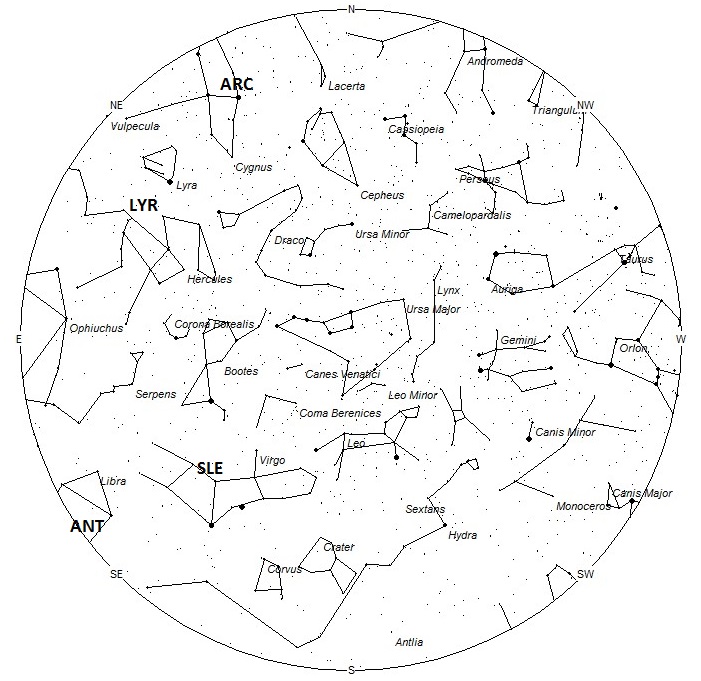
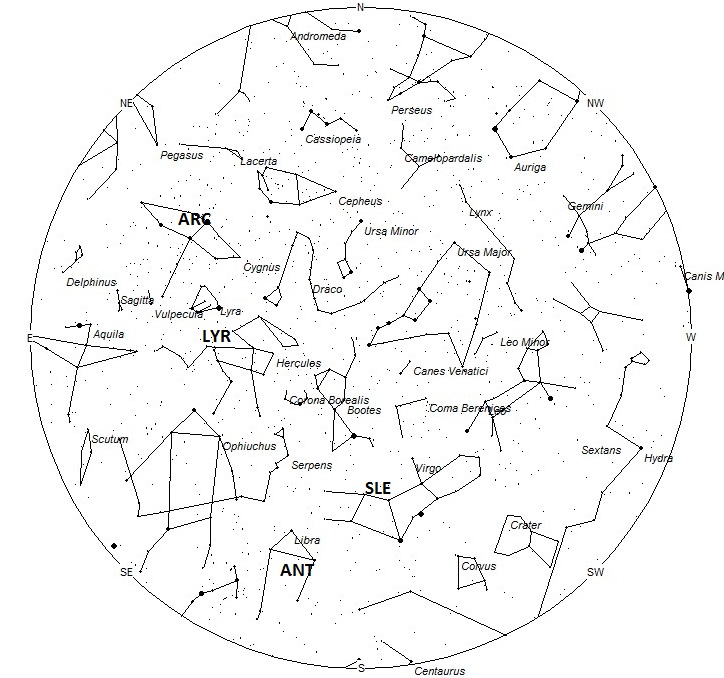
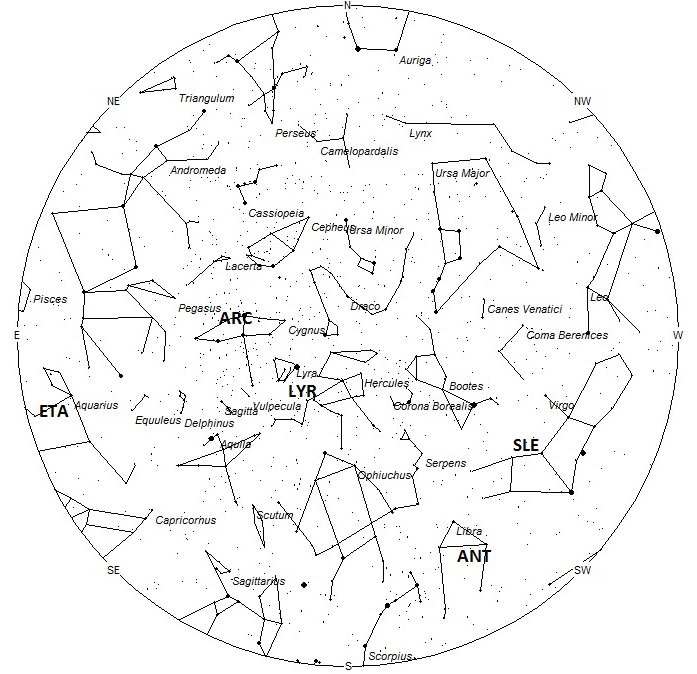

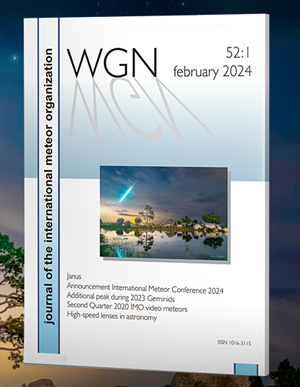
 You saw something bright and fast? Like a huge shooting star? Report it: it may be a fireball.
You saw something bright and fast? Like a huge shooting star? Report it: it may be a fireball.  You counted meteors last night? Share your results with us!
You counted meteors last night? Share your results with us!  You took a photo of a meteor or fireball? You have a screenshot of your cam? Share it with us!
You took a photo of a meteor or fireball? You have a screenshot of your cam? Share it with us!  You caught a meteor or fireball on video? Share your video with us!
You caught a meteor or fireball on video? Share your video with us!